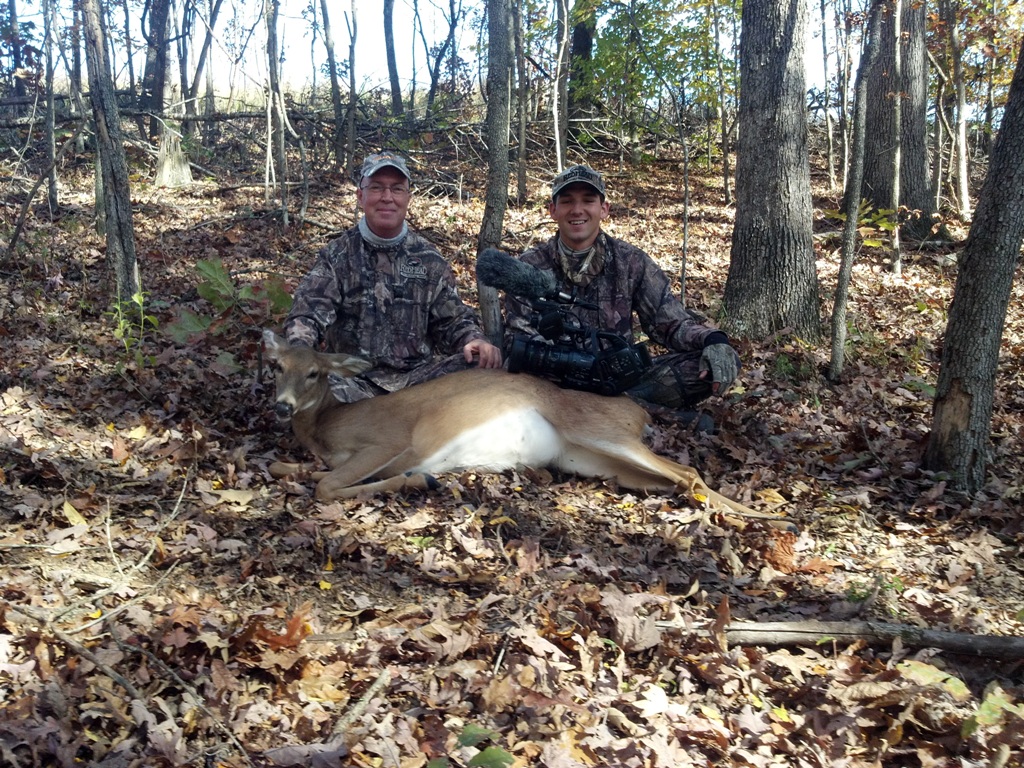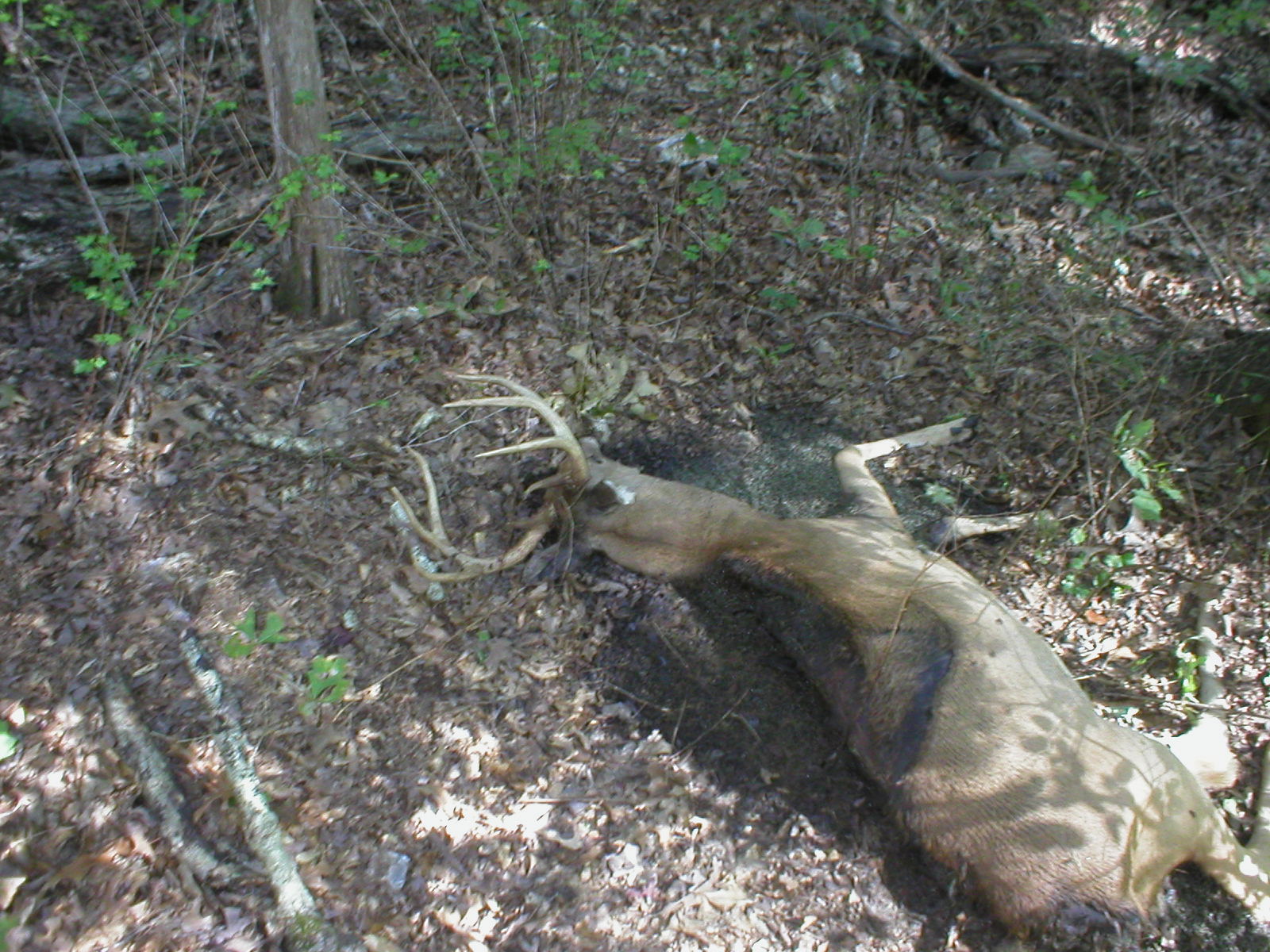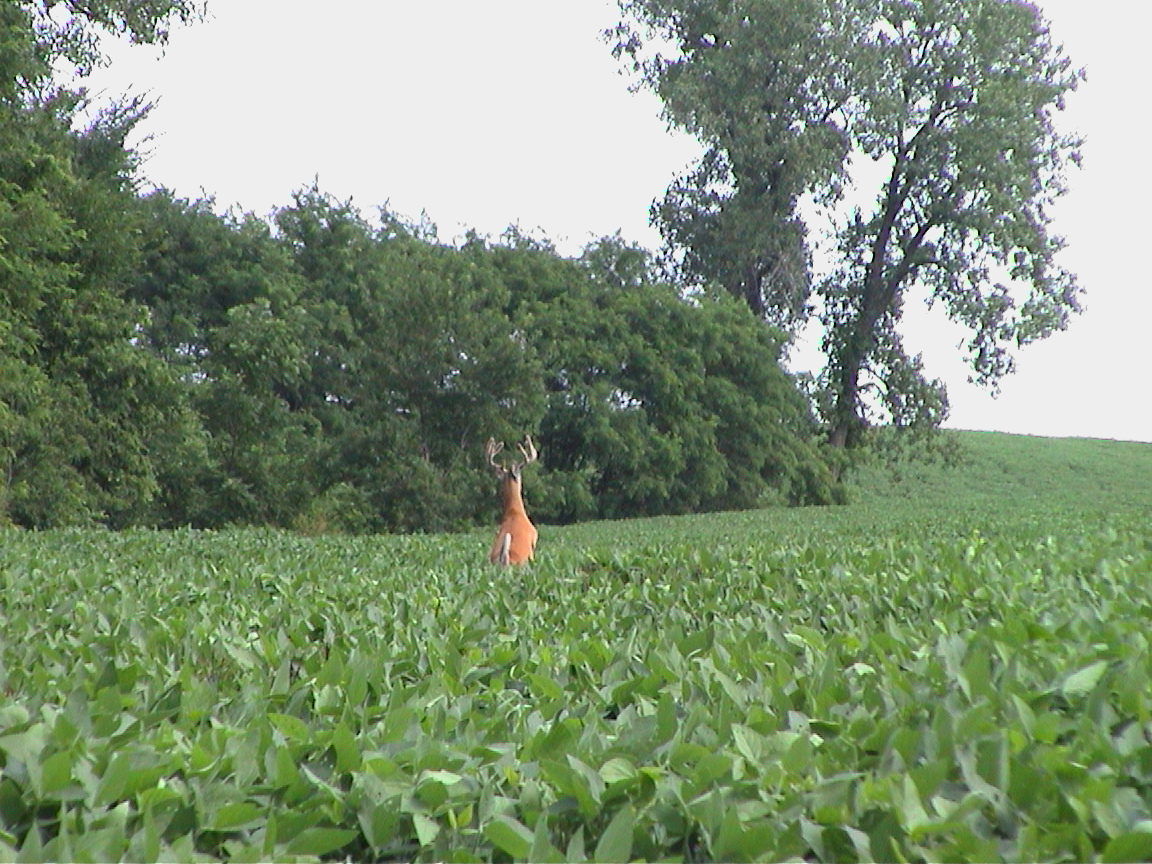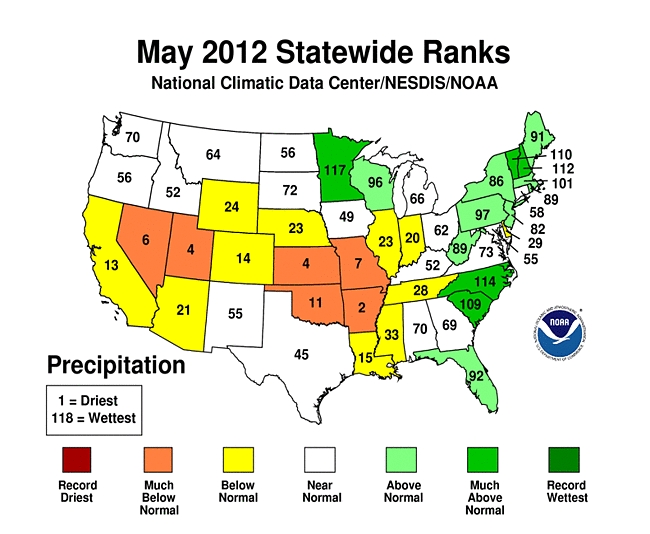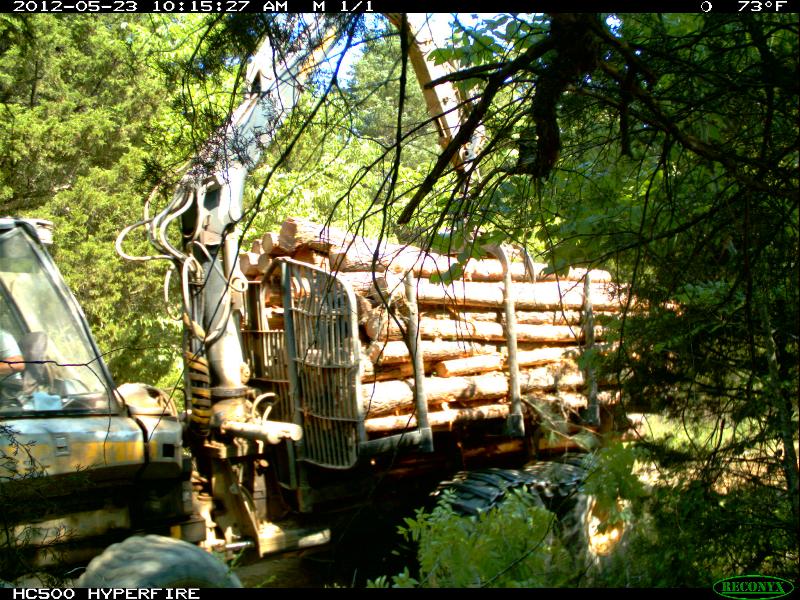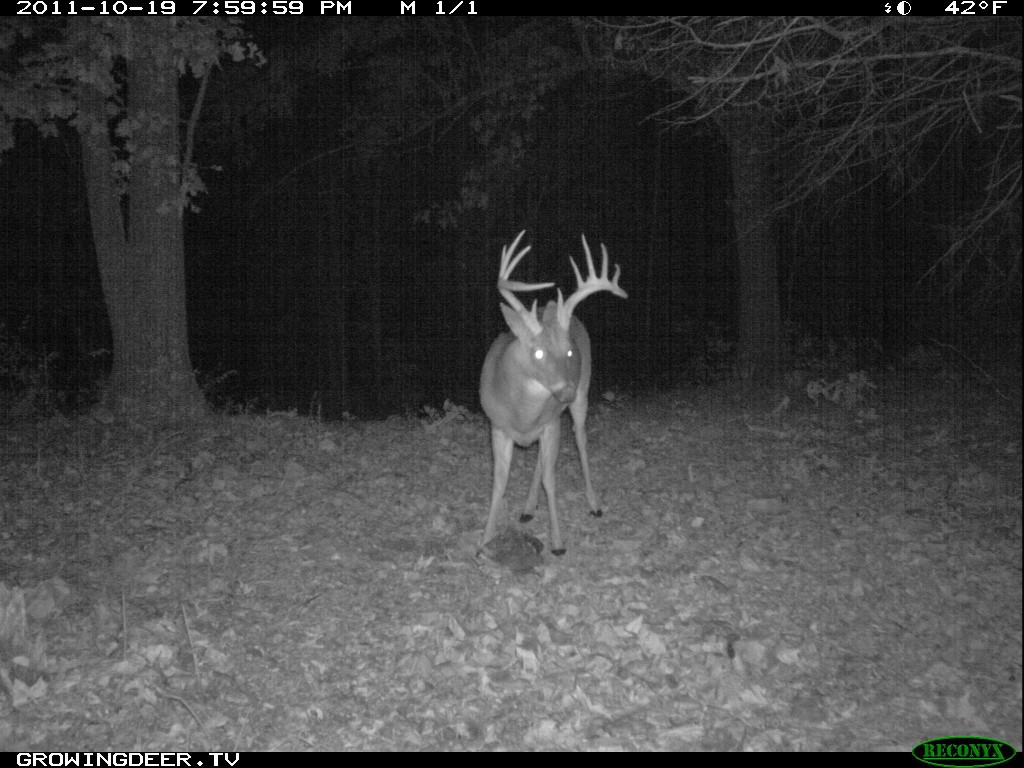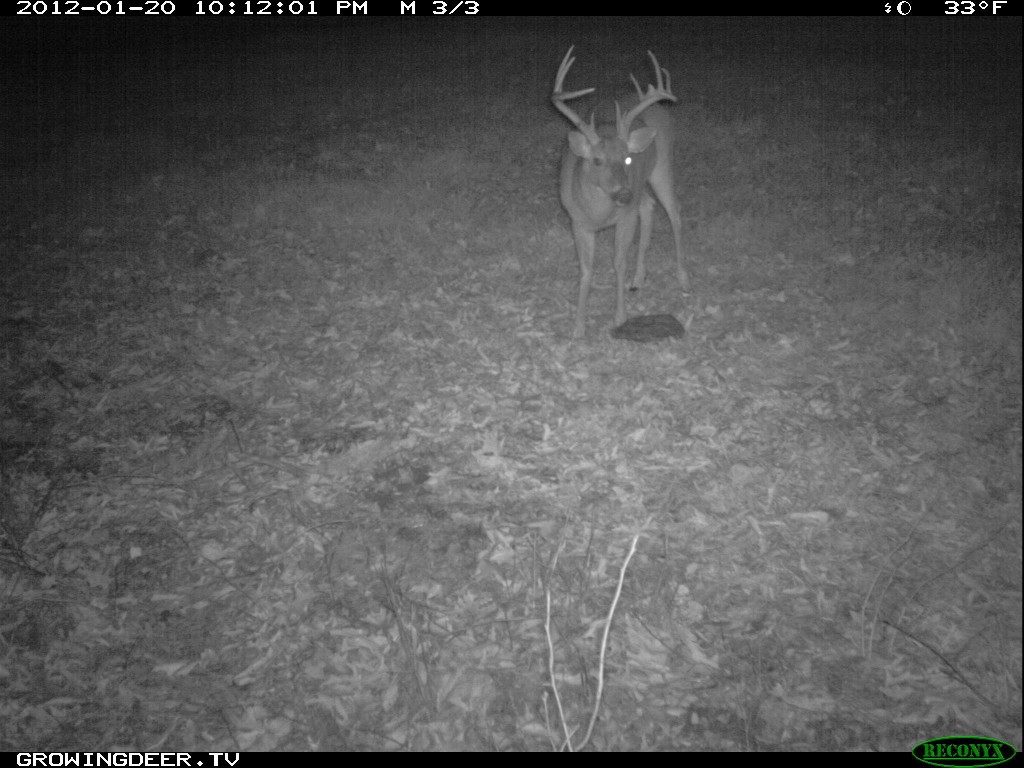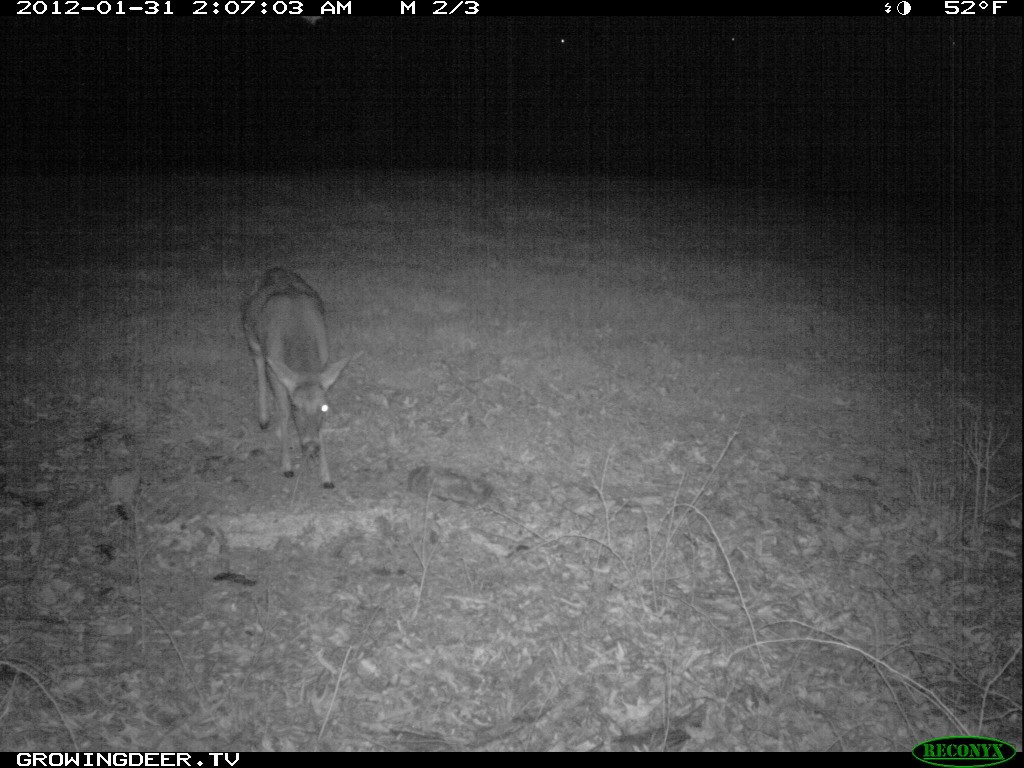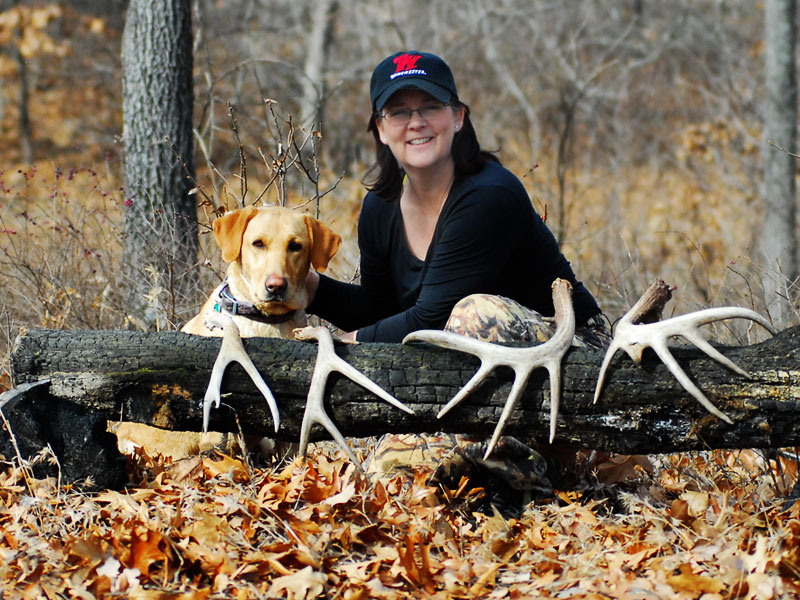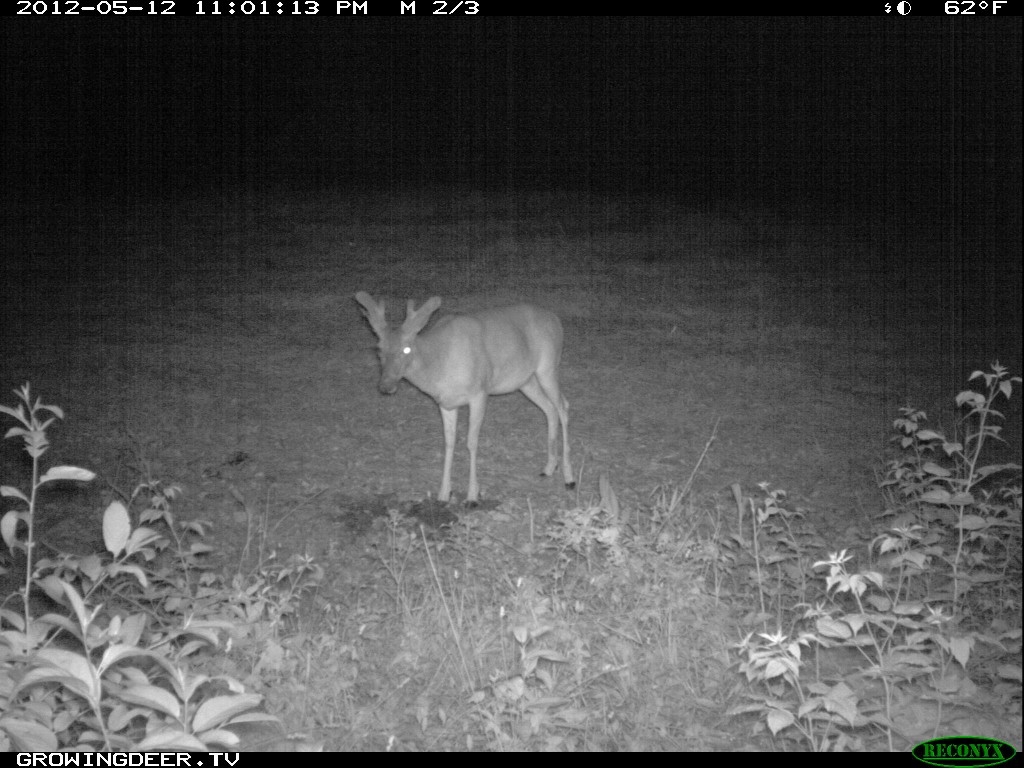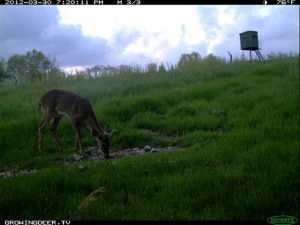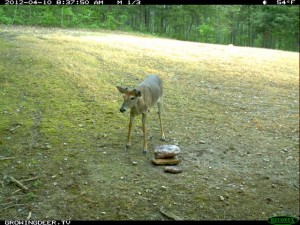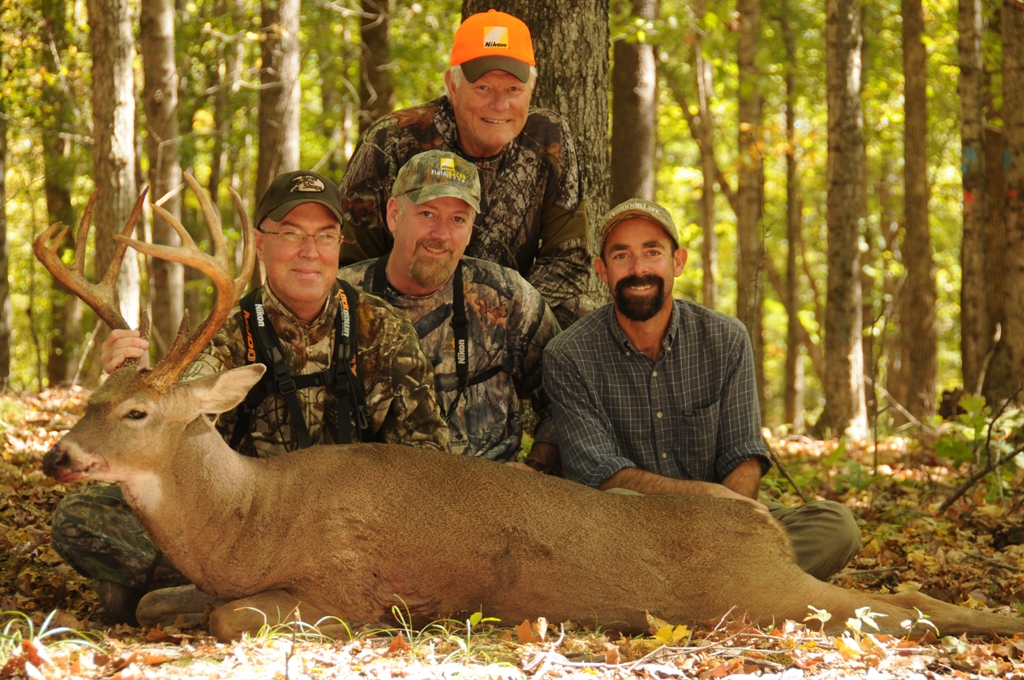Category: Deer Management
Why Bucks Are Shedding Antlers Early
Throughout the whitetails range I am receiving reports and photos of bucks that are already shedding their antlers. Since early December 2012 I’ve gotten several Reconyx trail camera pictures of bucks that have already shed one or both antlers here at The Proving Grounds. It’s common for an occasional buck to shed early due to injury. However, I suspect about 10%+ of the bucks at my place have already shed.
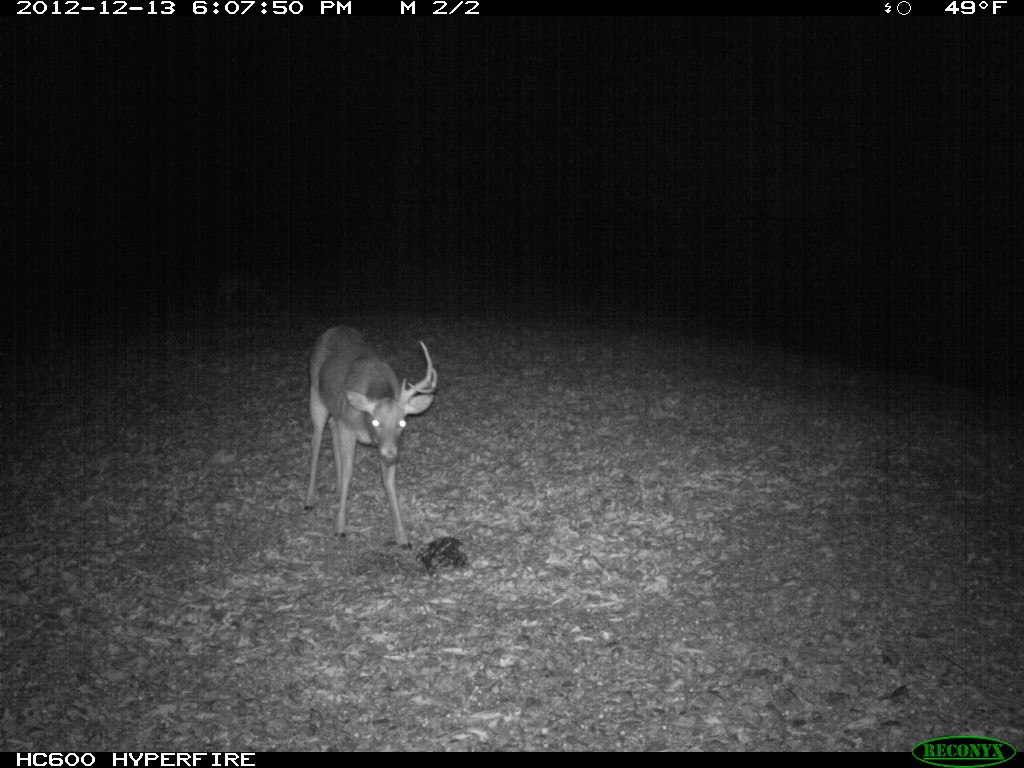
Since early December 2012 I’ve gotten several Reconyx pictures of bucks that have already shed one or both antlers.
Early shedding is a sign of stress. I’m sure deer at my place are stressed. During the 2011 growing season we experienced an extended drought followed by a record drought (the driest July during 118 years of record keeping) during 2012. Plants can’t transfer nutrients without water. Therefore forage quality was most likely severely decreased during the past two years.
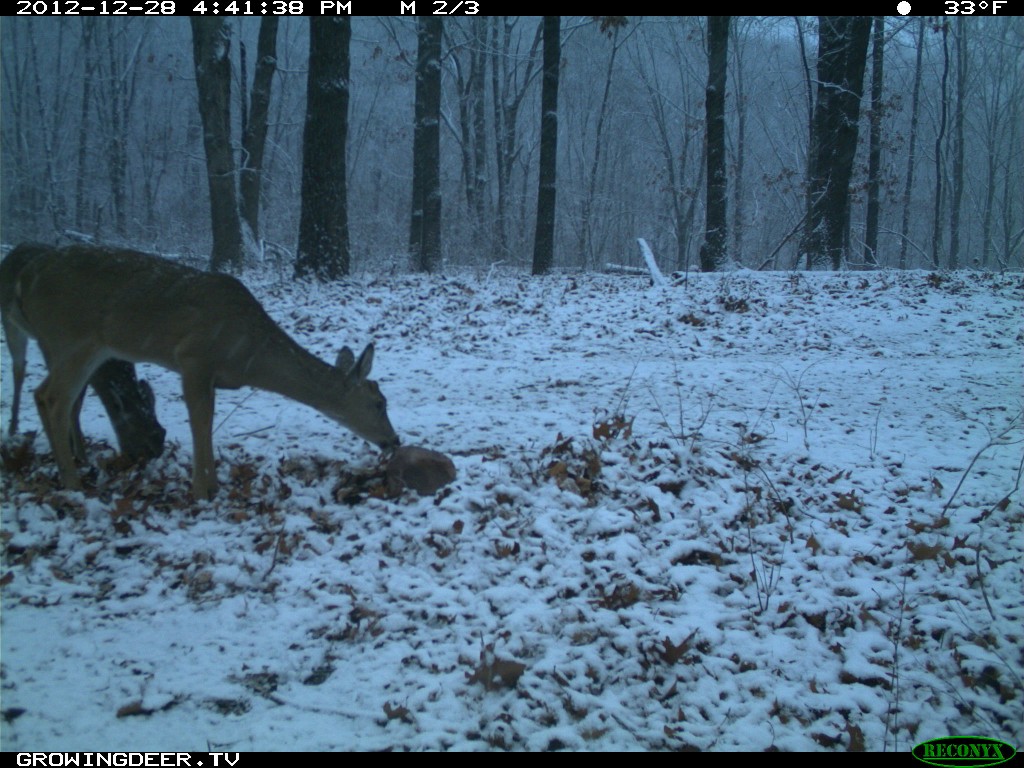
During the past two years the deer at my place experienced extended drought and a major outbreak of EHD.
There was also a major outbreak of EHD at my place (as in many places from Florida to Wyoming) last fall. There are two forms of EHD, acute and chronic. Deer with the acute form of EHD usually die within 24 to 36 hours. Deer with the chronic form may or may not die. If they do die, it often takes months.
We’ve found bucks that probably died from both forms of EHD (GDTV 147). The good news is that Mrs. Tracy will likely find a lot of sheds this year! The bad news is that she will also find a lot of skulls of bucks that died before they shed their antlers. I’ll keep you posted as Tracy and Crystal begin shed hunting. They will start just as soon as the archery season closes in Missouri (January 15, 2012).
I’ll begin a supplemental feeding program using the high quality feeds from Record Rack. I’ve never used supplemental feed before at The Proving Grounds. However, given the drought and amount of stress the herd is experiencing at my place, I think supplemental feeding is a very smart management strategy. I’ll keep you posted on our feeding program through this blog, on my Facebook page, and on GrowingDeer.tv!
If you’ve never used supplemental feed before, stay tuned and I’ll show you how and why I opted to use this strategy from a biologist’s point of view.
Growing Deer together,
Grant Woods, Ph.D.
Wildlife Biologist
Why Bucks Shed Antlers Early
The rut is tough. It’s probably like playing professional football without pads! Certainly some players would get hurt. The same is true with deer. Some bucks get hurt (gored, kicked, etc.) during the rut.
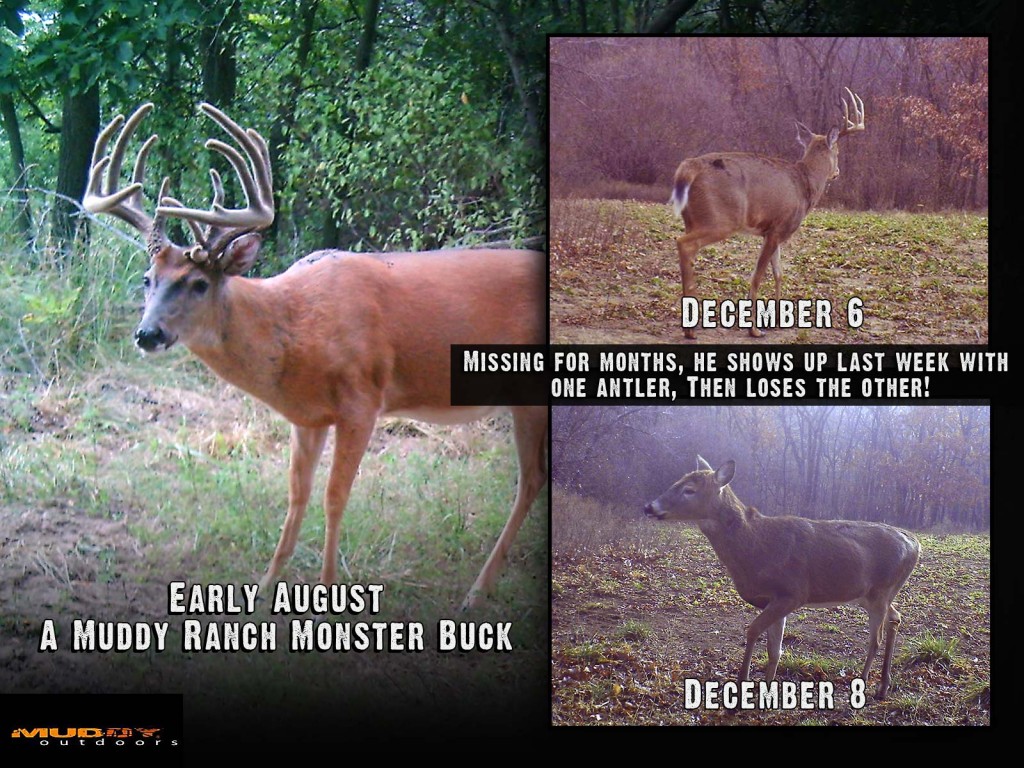
Muddy Ranch buck sheds early
Bucks shed their antlers when certain hormones, primarily testosterone, drop below minimum levels. A buck’s testosterone level can drop earlier than normal if he is injured or sick. A few bucks are injured every year during the rut so it’s common to hear of a buck or two that someone saw or got a trail camera pic of during early December that has already shed.
This year may be a bit different. The largest outbreak of hemorrhagic disease that’s been recorded in 55 years occurred. Record droughts occurred throughout much of the whitetail’s range resulting in decreased forage quality and production. In short, many deer herds experienced a LOT of stress during 2012.
I knew all of this, but wasn’t prepared for all the reports, trail camera pics, etc., I’ve already received from folks about bucks that have already shed! The subjects of my recent blogs were about why I like and the techniques I use to tag bucks during the late season!
I’ll still hunt until the end of season (January 15th at my place in Missouri). However, the number of hit list bucks that hold their antlers till then will be slim. The good news is that I can begin shed hunting January 16th!
Growing Deer together,
Grant
Deer Activity – Moon, Rut, or Weather?
I just shot a doe three hours before writing this. I saw her and a yearling buck. They were feeding on acorns. It’s October 25th and I’ve been hunting with three other guys for three days. None of us have seen a mature buck. I think it’s easy to explain why. The temperature each day has peaked at 80+ degrees.
I’m sure there will be some that will say deer are breeding late due to the drought, etc. However, that’s not the case. Years ago several researchers and I compared 1,000’s of conception dates collected from does harvested during the late season. The data was collected over several years and represented several states.
The strongest factor that predicted when the rut occurred was when it took place the previous year – not the phase, declination, etc., of the moon or any weather pattern. Timing of deer breeding is based primarily on genetics – not day to day factors.
Timing of breeding and daytime deer activity are not necessarily related. Several of my buddies have arrowed some whopper bucks during the past week in the western states – where the temperatures have dropped below normal. I was hunting at The Kentucky Proving Grounds early this week where the temperatures have been above normal. Even though the deer herd at The Kentucky Proving Grounds is a well managed deer herd, even healthy deer remain inactive during days with high temperatures.
From 20+ years of keeping records, there’s a strong trend that once deer start putting on fat along with their winter coat they simply don’t like moving during daylight, especially when the temperatures are above normal during daylight hours – no matter the date on the calendar.
I hunt when I can, but I expect more success when the daytime temperature is 10-20% below normal. I watch the weather forecast much more than moon phases or the state of the rut. The daytime temperatures are predicted to drop 30 degrees the next couple of days. I’ll let you know next week if the big bucks begin moving during daylight after the temperatures drop!
Growing (and hunting) Deer together,
Grant
Hunting Whitetails: How Will EHD Affect Hunting?
Literally 1,000’s of bucks, does, and fawns have been found dead during the past few weeks from South Dakota to North Carolina. The likely cause of death is EHD (Epizootic Hemorrhagic Disease) or BT (Blue Tongue).
For more information about these viruses read the epizootic hemorrhagic disease fact sheet.
The only known method to stop the deaths from EHD is a killing frost that will kill the flies that carry the virus from deer to deer.
I’ve received several questions asking if hunting should continue given the extent of EHD. There isn’t a black and white answer that covers all areas. In my home state of Missouri, there have been no deer found that were suspected to have died from EHD or BT in some counties. In other counties more than 100 dead deer have been found.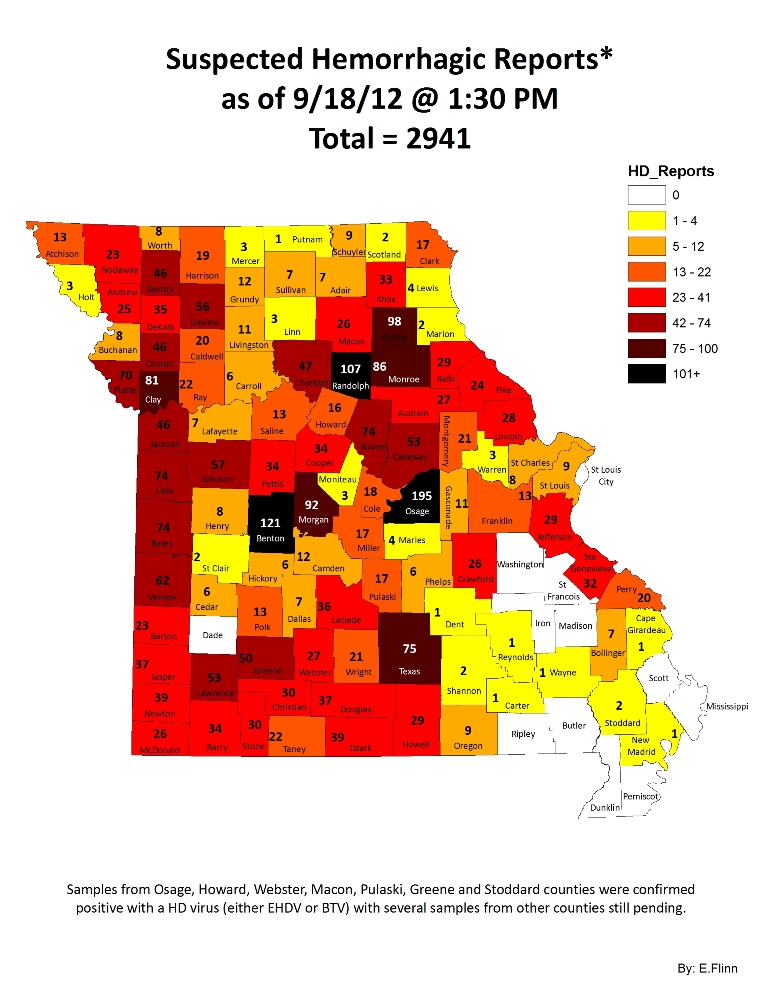
Dead deer tend to decompose or be consumed by predators/scavengers rapidly during the warm days of late summer. Hence, the number found and reported is likely a gross underestimation of the total killed by the viruses. It is doubtful state agencies will have the resources to survey deer herds in localized areas. Certainly they won’t be able to survey the herds before the 2012 season (which has already begun in some areas).
There are exceptions. South Dakota’s Game, Fish, and Parks department is offering a refund for 2012 deer licenses. They state they may make further adjustments as needed. However, this action won’t be required by most states. The impact of the virus will vary by location. This is why each hunter and/or land manager needs to assess the impact in their area and set their harvest objectives accordingly.
Whether there is a die-off or not, deer herd harvest objectives should be based on the ratio of deer to the amount of quality habitat available. If you hunt/manage deer in areas with lots of row crops, then food is rarely a limiting resource. If you hunt in areas that are primarily timber and/or pasture, then the deer population must be kept smaller so the number of deer doesn’t exceed the habitat’s ability to produce quality food.
I have a friend that owns and hunts 75 acres. He’s already found 5 dead deer (including the largest buck that he knew was using his property). Based on camera surveys and observations, probably 1/3 of the deer that used his property have already died. It is 20 days before it normally frosts where he hunts. It is very possible that another 1/3 of his herd could die before a frost kills the flies that carry the virus from deer to deer. It may be best for my friend to not harvest deer this year – depending on what happens during the next few weeks.
That prescription should not be automatically accepted for other areas. However, it should serve to make hunters and landowners aware that this year may not be business (deer harvest) as usual. I strongly recommend all hunters and landowners to observe the number of deer in their area. Visit with neighbors and other local hunters and get their observations.
My friend has already taken steps towards helping his deer herd recover. Yesterday while out checking for deer sign, he shot a coyote. Predation can have a larger impact on suppressed deer herds compared to those that are near the habitat’s capacity. If you’ve never been a predator hunter, this is the year you should seriously consider becoming one.
I’ll be using my Duke Traps and Fox Pro caller this year. I expect to have a busy year as I have a lot of friends that may need a bit of help removing some stress from their surviving deer herd.
Growing Deer together,
Grant
Antler Size and Food Plots
It’s certain that the quality of forage bucks consume is a huge factor in the size of antlers they produce. If your goal is to manage deer to produce better antlers, you must improve the quality of their diet. Establishing and maintaining food plots is probably the most practiced method of improving the quality of forage available to a local deer herd.
The phrase “food plots” is a very generic term. It’s used to describe everything from very small hidey hole plots best used to attract deer into shooting range to large ag fields that are capable of providing most of the quality forage necessary for all the deer in that area.
Unfortunately the lack of a precise definition has created some unsatisfied hunters. Some folks plant a hidey hole sized food plot and are upset when they don’t see an increase in average antler size.
Deer will consume several pounds of forage daily. At one end of the spectrum, it’s easy for a few deer to consume all the forage in a small plot before it provides any measurable advantage toward the herd’s health. The other end of the spectrum is the large production soybean fields in the Midwest. There are so many acres of soybeans in many areas that deer densities of even 100+ deer per square mile still have plenty to eat. This is a primary reason that deer in these areas produce larger antlers and more fawns than in areas where the landscape is primarily covered with trees.
Research has shown that in areas with relatively poor habitat (all trees, no crops, limited early succession habitat), just 1-2% of land in high quality food plots can make noticeable increases in average antler size!
However, to have this type of success, it requires more than simply scratching the dirt in an acre or two for each 100 acres. To increase the average antler size the deer must consume the forage, the forage must be available throughout the early and mid growing season and year round is better. The forage must transfer nutrients to deer.
This means the forage must be high quality (Eagle Seed forage soybeans have tested among the highest in digestible protein of all forage crops by multiple universities), and produce enough tons of forage to feed the herd.
Food plots can be a great hunting and herd quality tool. However, like most things in life, you rarely get more out of them than you put into them. There is no magic recipe. Food plots designed to improve herd quality require time and effort to establish. They also require ample soil moisture – which is currently missing from much of the whitetail’s range. I hope there is adequate soil moisture where you plant food plots!
Growing Deer together,
Grant
Scouting Whitetails With N.O.A.A.
It’s been very dry throughout much of the whitetail’s range so far during antler growing season. For example it was the second driest May since records have been kept in Arkansas, fourth in Kansas, seventh in Missouri, and eleventh in Oklahoma. N.O.A.A has been keeping records 118 years. It has been very dry during the growing season in these states.
These rankings are based on statewide averages. I think it is drier at my place (just a few miles from Arkansas) than the Missouri average indicates. Likewise, I’m sure some areas in these states have received an isolated thunderstorm or two and aren’t as dry as indicated by these statewide averages.
Plants need water to transport nutrients from the soil and air into and throughout the plant. Without adequate moisture, plants are simply not as nutritious compared to more normal growing conditions. Remember plants are simply transfer agents and if plants are lacking nutrients, so are the critters that consume them. Deer in drought areas won’t produce as large of antlers or as many (or healthy) fawns compared to the same deer during better growing conditions (different years).
Therefore droughts have a huge impact on hunters deciding on where (which state or region) to go hunting and deer herd managers deciding on whether to harvest bucks during drought years. I use maps to plan where to hunt and data from N.O.A.A can be a very valuable scouting tool!
Is the primary goal of planning an out of state hunt is to chase deer with larger antlers than what’s typically produced near your home? Then studying the N.O.A.A. data and determining the severity and duration of droughts can be just as important as studying the average antler size from specific counties, etc.
For example, planning a deer hunt in Kansas might not yield the expected results if that area is experiencing one of the worst growing season droughts during the past 100+ years. This is always dependent on the local conditions. For example, if you were planning to hunt near an irrigated soybean or alfalfa field, the drought might make the hunting better! The local herd had access to quality forage and all the deer in the neighborhood will likely be feeding at the irrigated crop versus spread out in the drought stricken native vegetation.
For deer managers that manage and hunt the same deer from birth through maturity, droughts may cause a different decision. Consider if you and your guests have passed bucks waiting for them to express 90+% of their antler growth potential. These bucks reach 4.5 years of age during an extreme drought. Due to a lack of quality forage, those mature bucks only express a portion of their antler growth potential – maybe not as much as they did when they were 3.5 years of age. The manager then has to decide if he and his guests will attempt to harvest the bucks even though they are only expressing a portion of their antler growth potential. This is a personal choice – one that should be based on the reason you/the landowner hunts.
Personally, I enjoy the challenge of hunting mature bucks and does. Given the extreme drought conditions at my place this year, I will focus on harvesting enough does to balance the amount of food available during these poor conditions. They will likely return again. During years with better growing seasons, each deer will have ample food to produce the best antlers and fawns they can.
I will also attempt to harvest a mature buck. I enjoy large antlers as much as most hunters. However, my primary satisfaction is being able to pattern and harvest a mature buck. My guests and I will only harvest a small portion of the mature bucks that our years of management efforts have yielded. I realize now that bucks will not express their full antler potential this fall. However, they will still be just as alert and skilled at avoiding predators (2 and 4 legged). The hunt will still score as much to me as if I was hunting during a year with average or better growing conditions.
I hope the growing conditions are good where you hunt. If not, I hope you still enjoy the hunt!
Growing Deer (during all conditions) together,
Grant
Big Bucks for Big Bucks
I’m returning from the Kentucky Proving Grounds as I write this. The Kentucky Proving Grounds is a tract of land owned by my friend, Mr. Hamby. His mission is to produce and hunt quality white-tailed deer and turkey and share those experiences with family and friends.
This week we started another project toward meeting Mr. Hamby’s mission. There are about 140 acres of loblolly pines in seven different stands that were planted 18 years ago at The Kentucky Proving Grounds. If pine trees are planted at a normal density (about 750 trees per acre), they will become so crowded that each tree will grow slower, be weakened and susceptible to disease and or insects.
Most critters or plants that are crowded don’t prosper for the same reasons. For example, deer herds that are overcrowded don’t express their full potential and are more susceptible to disease and/or insects.
When deer herds are overcrowded and damaging their habitat the best solution is to harvest excess reproductive units (does). The goal is to harvest some of the population to allow the rest to be healthier and not damage the habitat.
It’s the same with pine trees. By harvesting the excess trees, the remaining trees will grow faster and be less susceptible to most disease and insect threats. However a big difference is that the landowner can generate revenue by thinning trees! So when appropriate, thinning trees is a great way to improve the habitat, maybe clear food plot location, and make some revenue.
At The Kentucky Proving Grounds, Mr. Hamby has had me designate the flat and accessible locations to be clearcut (remove all trees) and establish new food plots. In the other portions of the pine stands, I instructed the loggers to remove the trees with less than desirable form, smaller diameter, etc., and insure that each residual tree has space around it’s crown so it can receive ample sunlight, moisture, and nutrients from the soil.
Good timber management is usually good deer management.
Growing Deer together,
Grant
Patterning Mature Bucks
I enjoy researching and managing deer. I’ve spent my career learning about deer – their behavior, how to improve their habitat, etc. However, my passion is driven by being a hunter – and learning how to pattern mature bucks. Patterning bucks simply means learning their habits, personality, and range.
Two tools that I use to pattern mature bucks are Reconyx trail cameras and Trophy Rocks. Even though it’s more than four months until deer season opens in Missouri, I’ve started patterning a mature buck I call Split Brow.
This is a picture of Split Brow from last fall. He was one of the bigger bucks that I knew about at my place. My Reconyx camera captured lots of images of Split Brow, but almost all of them were at night. I didn’t hunt for Split Brow as I had no indication he was moving during the day with any regularity. To my knowledge, he maintained this nocturnal only pattern through the hunting season. That’s not to say Split Brow wasn’t occasionally active during the daylight. However, the vast majority of pictures of him were at night. Hunting in his core area would have likely alerted him and I would have had a very small chance of seeing him during daylight. So, I hunted a buck that tended to be active more during daylight hours.
During the late season Split Brow apparently was in a tough fight. He was blinded in his right eye and broke the G3 of the left side of his rack. Disney got it wrong — life is not fun and games in the wild.
Split Brow shed his antlers soon after he received these injuries. I was worried he wouldn’t survive due to a secondary infection or internal injuries. Knowing that Split Brow had just shed, Tracy and Crystal (her lab) went hunting for his antlers. Since we had a Reconyx image of him that morning at a Trophy Rock with both antlers and another that evening showing he had shed both antlers, I knew Tracy and Crystal would have a relatively small area to search. Within an hour they had found both of Split Brow’s sheds.
Bucks aggressively seek trace minerals during the spring and summer (when antlers and fawns are developing) time of year so it was easy to see if Split Brow was alive by putting a Trophy Rock and Reconyx in his core area. It will be very interesting to watch his antlers develop this year and see if his antler configuration changes substantially.
Patterning bucks throughout the year helps me as hunter! It also teaches me much about how bucks use the existing habitat and what I need to do to improve it from a manager’s and hunter’s point of view. Stay tuned and I’ll keep you posted on how Split Brow develops this year and if his pattern changes to include more activity during the daytime. If it does, he’ll be at the top of my hit list.
In the mean time, grab some Trophy Rocks and dust off those trail cameras. It’s time to start patterning bucks where you hunt!
Growing (and patterning) Deer together,
Grant
Are You Seeing Antlers?
“Are you seeing antlers?” This time of year that question almost always means seeing bucks that have started growing a new set of antlers. However, that’s not the case this year. Due to the record warm winter and significantly lower than normal stress levels on deer, many bucks throughout the whitetails’ range are still holding antlers from the 2011-12 season.
At The Proving Grounds we got Reconyx images last week of bucks still holding antlers from last season and bucks that have shed and are starting to grow new antlers. I’ve even had a report of an image from Iowa of a buck that still has his antlers from last year and is starting to grow new antlers off to the side. That has happened before – but it is very odd.
I don’t know (and I doubt anyone does) what all this means as far as antler growth this summer. I strongly suspect the growing conditions this summer will be more of an influence on antler production more than the odd shedding pattern that is occurring. I’m very eager to see how antlers develop this summer! I would appreciate seeing trail camera images of bucks that haven’t shed as of today (April 13th). I’d also really appreciate any trail camera images of bucks that are growing their new antlers while still holding antlers from last year. (You can upload the images directly to my Facebook page.)
Odd years produce odd results. I’m eager to see how the average antler production during 2012 turns out!
Growing Deer (and learning) together,
Grant
Pt. 10: Top 10 Recommendations for Managing Land to Yield Mature, Huntable Deer
Part 10: Putting it all Together
I wrote this series to address several questions recently posted on my Facebook page. The questions were timely as there is a huge interest in hunting mature bucks. Folks are realizing that to hunt mature bucks, mature bucks must exist. For example, hunting mature bucks on properties where a majority of the yearling bucks are harvested annually is very frustrating.
Therefore it’s very important to have realistic objectives based on a property’s recent buck harvest. For example, if there have been an average of three bucks harvested per square mile on the property and/or neighborhood where you are hunting, there won’t likely be many bucks reaching maturity on that property. The bottom line is there must be mature bucks present to be harvested. Obviously, the more mature bucks in the area the better the odds of having an encounter with one. A higher percentage of the total buck harvest is usually composed of mature bucks in states with a more restrictive bag limit for bucks. Kentucky and Kansas are good examples of states with a restrictive buck bag limit and a trend of producing great mature bucks annually.
This is simply a trend. I’m aware of individual properties in most states that produce great mature bucks. These landowners or deer management cooperatives usually establish more favorable deer harvest guidelines than imposed by the state’s regulations. This is to say that the grass is not always greener on the other side of the fence (or border).
Simply allowing bucks to reach maturity doesn’t mean they will express their full antler growth potential. Bucks need an excellent source of nutrition throughout their life to express their full antler growth potential – in addition to living to maturity. Even further, the better health (good food, limited stress) the buck’s dam was in has an impact on the buck’s health.
This means that simply significantly increasing the quality of a buck’s diet for a year or two won’t necessarily allow him to express his full potential. The overall health of a buck (or other critter) is substantially impacted by their development years. When Tracy and I purchased The Proving Grounds, it was a horribly overgrazed cattle ranch. We’ve now owned it nine+ years and spent a lot of time and resources improving the habitat. However, the five year old bucks that are currently on our property were most likely from does that were raised in very stressful conditions. To determine the true potential of bucks at The Proving Grounds will require maintaining quality habitat long enough for does to be born from does that were raised with access to quality food and limited stress. Those does will need to have fawns, and then allow those male fawns to reach maturity. Let’s consider this three generations of deer – or 12+ years.
This process can be short cut if the property is in an area where quality nutrition has never been a limited factor, and the only missing piece of the deer management puzzle is allowing bucks to reach maturity. In other words, the lower the quality of habitat, the longer it will take to allow the herd to express its full potential. However, such land usually costs much less than row crop land where good nutrition has been available year round for many years.
I really enjoy the process of managing and hunting for mature bucks. I like going on suitcase hunts – hunting properties that I show up for a week or so a year and my only management activity is deciding to pass or pull the trigger. However, my passion is growing and hunting mature bucks. If you share my passion, we’ll keep learning together.
Growing Deer together,
Grant



